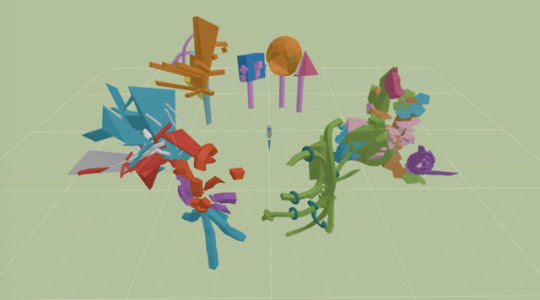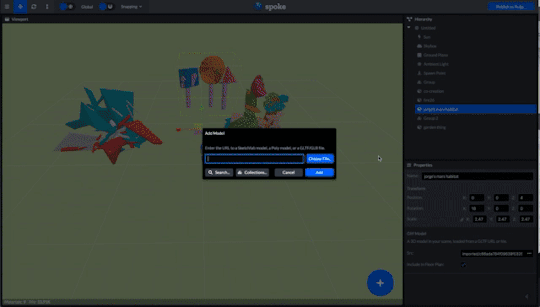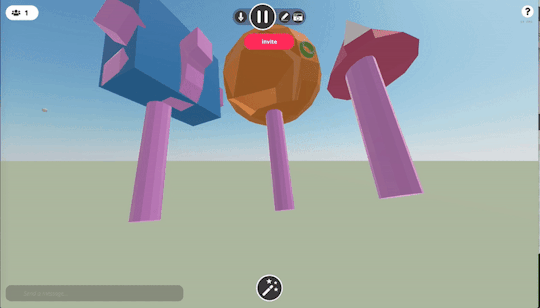This blog aims to counter the narratives put forth by the current paradigm of urban planning & development processes. Thesis work of Jessica Escobedo, MFA candidate at ArtCenter College of Design, Media Design Practices program.
Don't wanna be here? Send us removal request.
Text
Environments + Behaviors
I was just reading the series of articles published on Mozilla about a usability study for communicating in XR. In “How XR Environments Shape User Behavior” , the three key insights were:
Anticipate that people will want to explore upon arrival
Smaller spaces were easier for close conversations
Objects shaped people’s expectations of what the space was for
Since I’m currently trying to figure out what assets/content will be in these scenes, the last point has sparked some ideas about speculative design diegetic objects, and how I could do a series of scenes where I get very intentional/specific about these speculative objects, and change them to talk about ‘who they’re for,’ and what that could do in different contexts/spaces around Chinatown. The question is - why 3D/immersive and not tactile, real?
0 notes
Photo




Prototype 1
Using Mozilla Spoke + HUBS to create an accessible way for residents of Chinatown to experience, evaluate, and give input on proposals, (low poly 3D models) that were made by me and another Chinatown resident in Google Blocks using HTC Vive.
Limitations using Spoke/HUBS:
It seems that the only types of models I can upload when creating the scene on Spoke is Low Poly assets from Google Poly/Sketchfab or my own 3D static models. I tried to import Tilt Brush scenes but they didn’t work, both importing into Spoke and HUBS.
The user can move through the objects (no rigid bodies), giving less of a solid experience.
Notation is limited to the person’s ability to write using a digital medium (mouse, tablet). However, they can speak into it if they allow microphone permissions, which could be interesting as a type of data collection. (If I use Google Translate ML maybe I can visualize/translate what’s being said if they speak in Mandarin, Spanish?)
I can’t import audio in HUBS. :(
Generally, the UX of HUBS is pretty bad in terms of moving around in the web browser screen. On a mobile phone it is equally as bad, you’re using the gesture control of whatever device you’re using at the time.
Further Questions:
In general, I need to know what devices residents of Chinatown have access to, and what their internet/mobile communication paradigm is like. For example, if I create a social media account and communicate that way, send a link, send an email, etc. are people likely to use it? The cool thing about HUBS is that all you need is a link and a browser, so that already is more accessible than most VR headsets/AR experiences. But I still want to know who I’m not reaching.
How do people feel about low-poly artifacts when they see them in the scene v. when they’re creating them? The difference between something feeling like it already has an aesthetic *low poly* vs. something that has a very digital conceptual feel to it (like a wireframe, white/black), vs. an artistic rendering? (like a sketch, like watercolor) v. vaporware v. gaming v. photorealism etc.
Right now the assets’ content is meaningless, as is the relationship among them. What is the relationship between the object and the participation/interaction? Is it based on form, content, function, or aesthetics? What are the new hierarchies that are created from that, spatially or aesthetically? For example, if I make all objects white, does that make the user less biased? If I play around with arrangement, does that change anything?
What is the action that the user does to participate, given HUBS’ capabilities? Do they ‘take a photo’ of what they like? Do they ‘write’ something, as if there was a transparent post-it note? Or is it just an oral and behavioral recording of what they think out loud?
Next Steps: After attending and reading some of the documents expressing the community vision of Chinatown, I want to explore language and approaches different from the policy-oriented discussions that have been going on. Given that I am still fairly new to this community (about a year living here), and I have been away at school/interning, I have yet to really meet and engage with the community myself. I think the beginnings of creating relationships with the community and seeing how I can use media to engage in a conversation to get to know someone. So the first thing I should probably do is outline what information I need from people I’m talking to and what information I should provide them, who are seeing me as both a community member and a designer. Should I let them know my values, philosophy as a designer? How do I present myself? And how do I introduce the project to them? After that, I am also interested in playing around and sketching out all the different hierarchies (spatial, aesthetic, etc) that can be created within the VR space as well as work on the interactions/ways they communicate and can participate. Basically, what are the different scenes I am creating and why?
Notes: I think what’s interesting about creating these interactions in a social VR space is that by translating reality into a ‘controlled, and hopefully *safe* space,’ residents are disoriented in the way they would normally engage in on the street, giving us a third place to gather and understand each other; culturally, spatially. Perhaps soothing/meditative music can help set the “mood” for each of these scenes when asset building.
0 notes